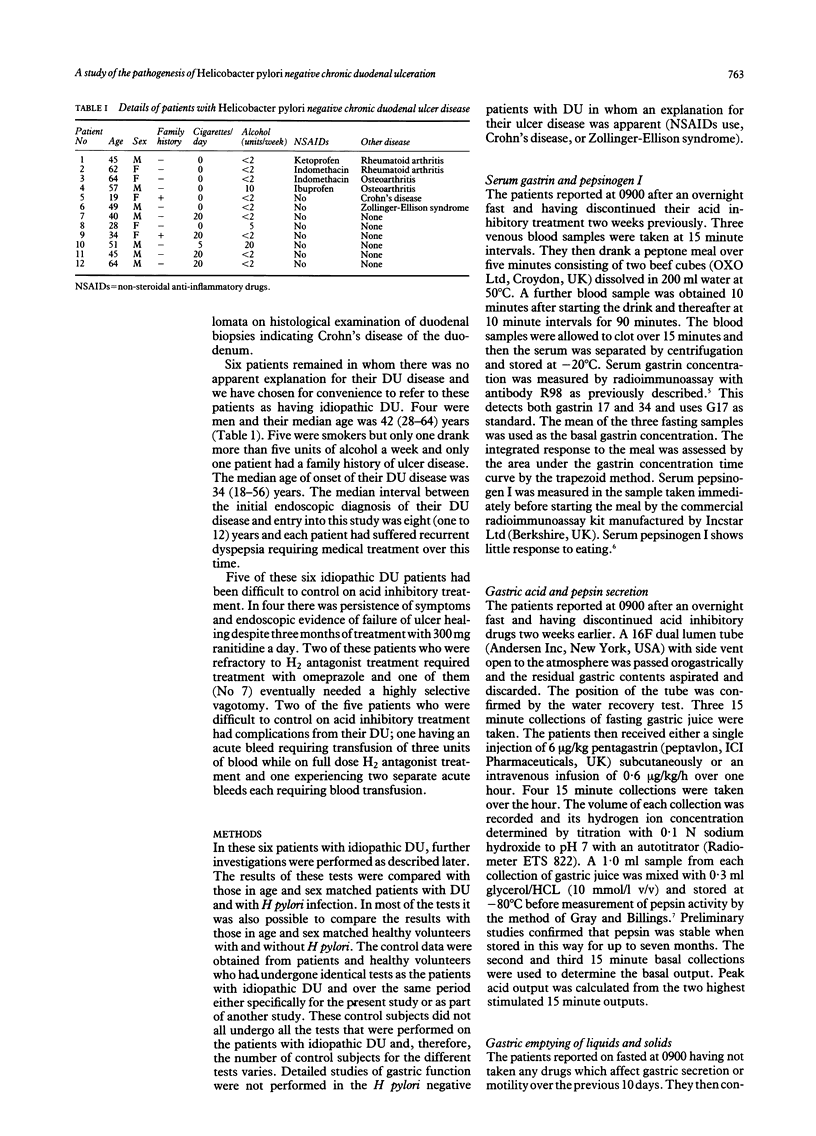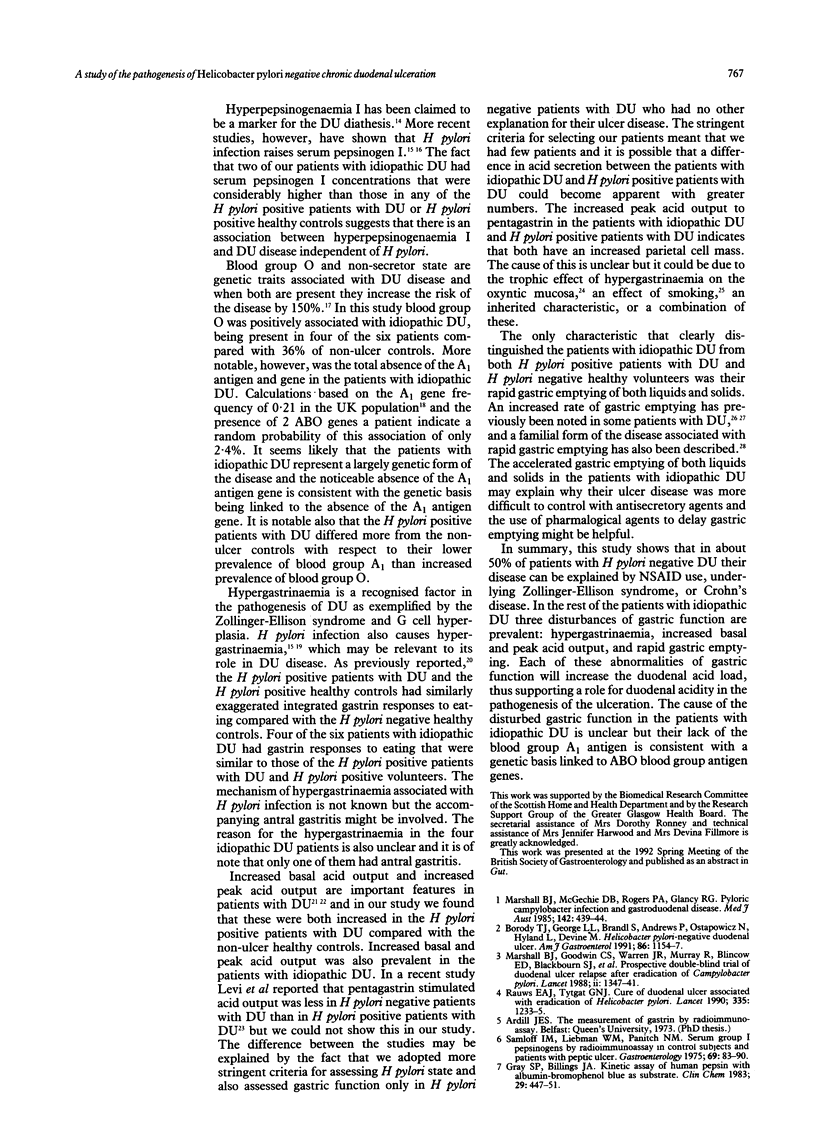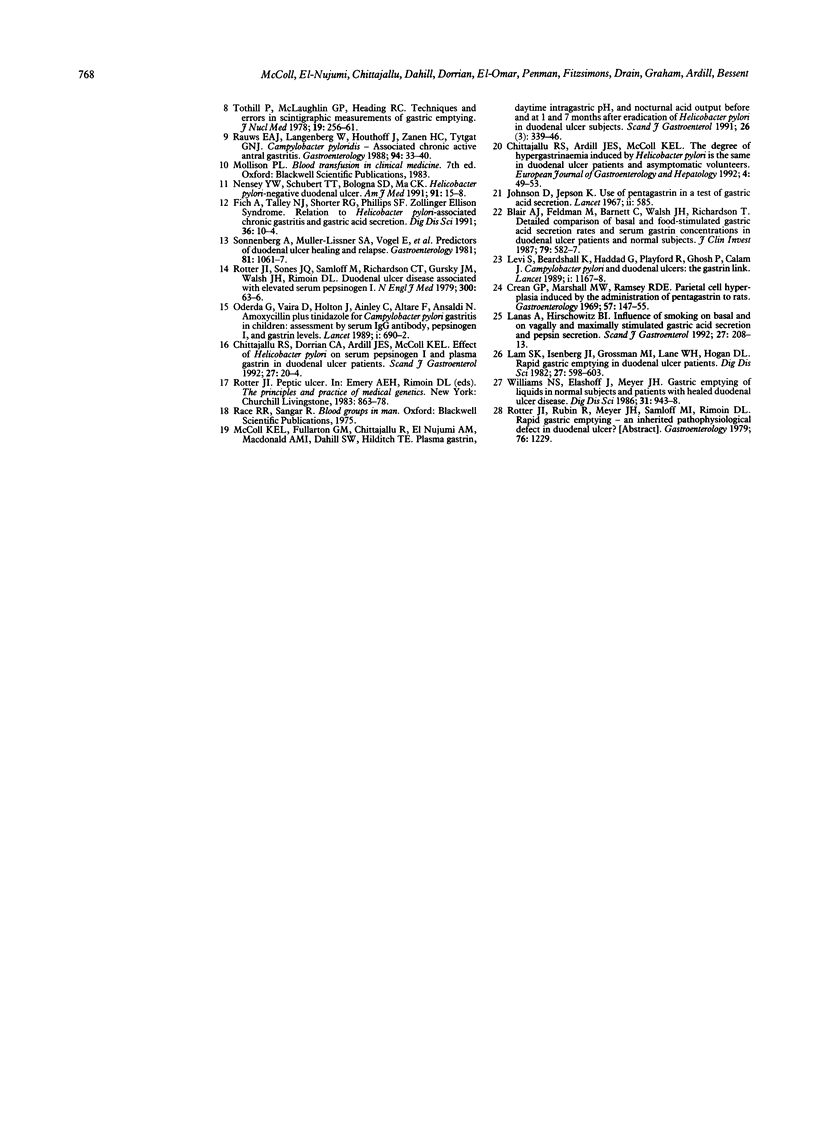Abstract
In the past five years 12 patients have been identified presenting with chronic duodenal ulcer (DU) disease and with no evidence of current or recent Helicobacter pylori (H pylori) infection. Four of them were taking regular non-steroidal anti inflammatory agents, one was subsequently found to have Crohn's disease of the duodenum, and one to have the Zollinger-Ellison syndrome. The remaining six patients with idiopathic DU disease were remarkable for their absence of the A1 blood antigen gene. Detailed studies of gastric function were performed in these six patients and compared with H pylori positive patients with DU and with healthy volunteers. The median integrated gastrin response in the patients with idiopathic DU (2810 (range 750-8750) ng/l min) was similar to that of the H pylori positive patients with DU (3355 (550-8725)) and higher than that of the H pylori negative healthy volunteers (560 (225-1125)). The median peak acid output in the patients with idiopathic DU (37 mmol/h, range 17-52) was similar to that of the H pylori positive patients with DU (40 (15-57)) and higher than that of the non-ulcer controls (22 (16-29)). The median percentage of a liquid meal retained in the stomach at 60 minutes was less in the patients with idiopathic DU (23 (15-33)) than in H pylori negative healthy volunteers (34 (30-53) p < 0.01). The median percentage of a solid meal retained at 60 minutes was less in the patients with idiopathic DU (54 (9-83)) than in either H pylori negative healthy volunteers (87 (49-95) p<0.01) or H pylori positive patients with DU (79 (51-100) p<0.01). In conclusion, three abnormalities of gastric function are prevalent in patients with H pylori negative idiopathic DU disease - hypergastrinaemia, increased acid secretion, and the one feature distinguishing them from H pylori positive patients with DU - rapid gastric emptying of both liquids and solids. Each of these abnormalities will increase the exposure of the duodenal mucosa to acid and thus explain its ulceration. The absence of the blood group A1 antigen gene is consistent with a genetic basis for the disturbed gastric function linked to the ABO blood group antigen genes.
Full text
PDF






Selected References
These references are in PubMed. This may not be the complete list of references from this article.
- Blair A. J., 3rd, Feldman M., Barnett C., Walsh J. H., Richardson C. T. Detailed comparison of basal and food-stimulated gastric acid secretion rates and serum gastrin concentrations in duodenal ulcer patients and normal subjects. J Clin Invest. 1987 Feb;79(2):582–587. doi: 10.1172/JCI112850. [DOI] [PMC free article] [PubMed] [Google Scholar]
- Borody T. J., George L. L., Brandl S., Andrews P., Ostapowicz N., Hyland L., Devine M. Helicobacter pylori-negative duodenal ulcer. Am J Gastroenterol. 1991 Sep;86(9):1154–1157. [PubMed] [Google Scholar]
- Chittajallu R. S., Dorrian C. A., Ardill J. E., McColl K. E. Effect of Helicobacter pylori on serum pepsinogen I and plasma gastrin in duodenal ulcer patients. Scand J Gastroenterol. 1992;27(1):20–24. doi: 10.3109/00365529209011160. [DOI] [PubMed] [Google Scholar]
- Crean G. P., Marshall M. W., Rumsey R. D. Parietal cell hyperplasia induced by the administration of pentagastrin (ICI 50,123) to rats. Gastroenterology. 1969 Aug;57(2):147–155. [PubMed] [Google Scholar]
- Dobutamine stress test. Lancet. 1988 Dec 10;2(8624):1347–1348. [PubMed] [Google Scholar]
- Fich A., Talley N. J., Shorter R. G., Phillips S. F. Zollinger-Ellison syndrome. Relation to Helicobacter pylori-associated chronic gastritis and gastric acid secretion. Dig Dis Sci. 1991 Jan;36(1):10–14. doi: 10.1007/BF01300079. [DOI] [PubMed] [Google Scholar]
- Gray S. P., Billings J. A. Kinetic assay of human pepsin with albumin-bromphenol blue as substrate. Clin Chem. 1983 Mar;29(3):447–451. [PubMed] [Google Scholar]
- Johnston D., Jepson K. Use of pentagastrin in a test of gastric acid secretion. Lancet. 1967 Sep 16;2(7516):585–588. doi: 10.1016/s0140-6736(67)90739-8. [DOI] [PubMed] [Google Scholar]
- Lam S. K., Isenberg J. I., Grossman M. I., Lane W. H., Hogan D. L. Rapid gastric emptying in duodenal ulcer patients. Dig Dis Sci. 1982 Jul;27(7):598–604. doi: 10.1007/BF01297215. [DOI] [PubMed] [Google Scholar]
- Lanas A., Hirschowitz B. I. Influence of smoking on basal and on vagally and maximally stimulated gastric acid and pepsin secretion. Scand J Gastroenterol. 1992;27(3):208–212. doi: 10.3109/00365529208999950. [DOI] [PubMed] [Google Scholar]
- Levi S., Beardshall K., Haddad G., Playford R., Ghosh P., Calam J. Campylobacter pylori and duodenal ulcers: the gastrin link. Lancet. 1989 May 27;1(8648):1167–1168. doi: 10.1016/s0140-6736(89)92752-9. [DOI] [PubMed] [Google Scholar]
- Marshall B. J., McGechie D. B., Rogers P. A., Glancy R. J. Pyloric Campylobacter infection and gastroduodenal disease. Med J Aust. 1985 Apr 15;142(8):439–444. doi: 10.5694/j.1326-5377.1985.tb113444.x. [DOI] [PubMed] [Google Scholar]
- McColl K. E., Fullarton G. M., Chittajalu R., el Nujumi A. M., MacDonald A. M., Dahill S. W., Hilditch T. E. Plasma gastrin, daytime intragastric pH, and nocturnal acid output before and at 1 and 7 months after eradication of Helicobacter pylori in duodenal ulcer subjects. Scand J Gastroenterol. 1991 Mar;26(3):339–346. doi: 10.3109/00365529109025052. [DOI] [PubMed] [Google Scholar]
- Nensey Y. M., Schubert T. T., Bologna S. D., Ma C. K. Helicobacter pylori-negative duodenal ulcer. Am J Med. 1991 Jul;91(1):15–18. doi: 10.1016/0002-9343(91)90067-8. [DOI] [PubMed] [Google Scholar]
- Oderda G., Vaira D., Holton J., Ainley C., Altare F., Ansaldi N. Amoxycillin plus tinidazole for Campylobacter pylori gastritis in children: assessment by serum IgG antibody, pepsinogen I, and gastrin levels. Lancet. 1989 Apr 1;1(8640):690–692. doi: 10.1016/s0140-6736(89)92206-x. [DOI] [PubMed] [Google Scholar]
- Rauws E. A., Langenberg W., Houthoff H. J., Zanen H. C., Tytgat G. N. Campylobacter pyloridis-associated chronic active antral gastritis. A prospective study of its prevalence and the effects of antibacterial and antiulcer treatment. Gastroenterology. 1988 Jan;94(1):33–40. [PubMed] [Google Scholar]
- Rauws E. A., Tytgat G. N. Cure of duodenal ulcer associated with eradication of Helicobacter pylori. Lancet. 1990 May 26;335(8700):1233–1235. doi: 10.1016/0140-6736(90)91301-p. [DOI] [PubMed] [Google Scholar]
- Rotter J. I., Sones J. Q., Samloff I. M., Richardson C. T., Gursky J. M., Walsh J. H., Rimoin D. L. Duodenal-ulcer disease associated with elevated serum pepsinogen I: an inherited autosomal dominant disorder. N Engl J Med. 1979 Jan 11;300(2):63–66. doi: 10.1056/NEJM197901113000203. [DOI] [PubMed] [Google Scholar]
- Samloff I. M., Liebman W. M., Panitch N. M. Serum group I pepsinogens by radioimmunoassay in control subjects and patients with peptic ulcer. Gastroenterology. 1975 Jul;69(1):83–90. [PubMed] [Google Scholar]
- Sonnenberg A., Müller-Lissner S. A., Vogel E., Schmid P., Gonvers J. J., Peter P., Strohmeyer G., Blum A. L. Predictors of duodenal ulcer healing and relapse. Gastroenterology. 1981 Dec;81(6):1061–1067. [PubMed] [Google Scholar]
- Tothill P., McLoughlin G. P., Heading R. C. Techniques and errors in scintigraphic measurements of gastric emptying. J Nucl Med. 1978 Mar;19(3):256–261. [PubMed] [Google Scholar]
- Williams N. S., Elashoff J., Meyer J. H. Gastric emptying of liquids in normal subjects and patients with healed duodenal ulcer disease. Dig Dis Sci. 1986 Sep;31(9):943–952. doi: 10.1007/BF01303215. [DOI] [PubMed] [Google Scholar]


